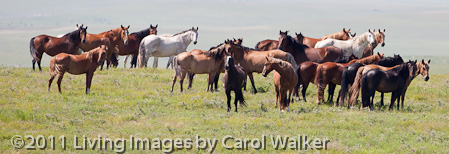by Debbie Coffey Copyright 2014 All Rights Reserved.

Mares look at the public on a BLM tour of Long Term Holding pastures in Kansas. (photo by Carol Walker)
Over the course of several weeks, with no transparency (unless a member of the public happened to call to directly ask), the BLM recently shipped about 1,770 wild horses, who were supposedly “living out their lives” on the Teterville Long Term Holding Pasture in Kansas, to other long term holding pastures and to a TEMPORARY SHORT TERM HOLDING FACILITY, in feedlot like conditions.
Approximately 1,400 mare were shipped to the Temporary Short Term Holding Facility in Scott City, Kansas.
Approximately 100 geldings were shipped to Cassoday Long Term Holding in Kansas.
Approximately 100 geldings were sent to Hulah Long Term Holding in Oklahoma.
Approximately 35 geldings were shipped to Catoosa Long Term Holding in Oklahoma.
Approximately 100 geldings were shipped to Bartlesville Long Term Holding in Oklahoma.
Approximately 35 geldings were shipped to Whitehorse Long Term Holding in Oklahoma.
The so called “notification” that the BLM gave the public, (if you happened to be browsing the From the Public page of their website, was this:
“Question: Does the BLM ever move animals from a long-term pasture to another holding facility? If so, why? (July 2014)
Answer: Yes, BLM moves animals from long-term pastures to other facilities if the long-term pasture can no longer accommodate the animals. Examples of when this would occur include:
1. If a contractor sells the ranch and the new owner does not want to manage for wild horses.
2. If a contractor has lands recovering from drought and wants to remove grazing animals or decrease their numbers to aid in drought recovery.
3. If market conditions change in the livestock sector such that the contractor identifies a more lucrative use for the land.
Depending on the capacity of the facility needing to relocate animals, the number of animals being relocated can range from a few hundred to a few thousand head.
The majority of animals that have not been adopted are held on long-term pastures. Long-term pastures provide a free-roaming environment for the animals and it costs less for the taxpayer to house animals on long-term pastures than at short-term holding facilities. With long-term and short-term facilities nearly filled to capacity, the BLM is currently seeking new short-term and long-term holding facilities.”
Okie dokie. I have some comments about this:
1) The BLM didn’t even bother to mention (notify the public) that they shipped 1,770 wild horses out of the Teterville Long Term Holding Pasture in the vague “answer” to their own generic question.
2) The BLM, in charge of “managing” (and planning for the “care” of) the wild horses for about 42 years, didn’t have the foresight that the conditions they listed above might happen, and have another Long Term Holding Pasture on a waiting list.
3) The public would like a tour of the TEMPORARY SHORT TERM HOLDING FACILITY in Scott City, Kansas. We are tired of the BLM moving our wild horses onto private property, and out of sight. The BLM needs to be accountable to the public.
4) Per BLM’s Debbie Collins, the “notification” of the horses being shipped from Teterville would be in the form of showing the numbers of additional horses at certain LTH facilities and the Temporary Short Term Holding Facility in Kansas on the BLM’s next “Off The Range” Facility Report. Of course, this report isn’t easy to find on the BLM’s Wild Horse & Burro website. And that really doesn’t adequately inform the public that wild horses were shipped out of Teterville Long Term Holding, does it? Are we on a scavenger hunt for tidbits of information?
5) The BLM has issued bids for new Long Term Holding Pastures, but it could take up to a year. Meanwhile, 1,400 mares may have to go through a harsh winter in western Kansas in a feedlot like corrals.
6) Debbie Collins seemed not to know, or did not want to tell me, the name of the contractor/ranch/facility for the Temporary Short Term Holding facility in Scott City. A member of the public shouldn’t have to file a FOIA for something like this. BLM employees, and the Wild Horse & Burro Program, are paid with public tax dollars and should answer questions. No wonder the BLM’s FOIA office is swamped. (Don’t worry, we’ll find out.)
7) The BLM continues to blatantly lack transparency.









Greeat reading your post
ReplyDelete